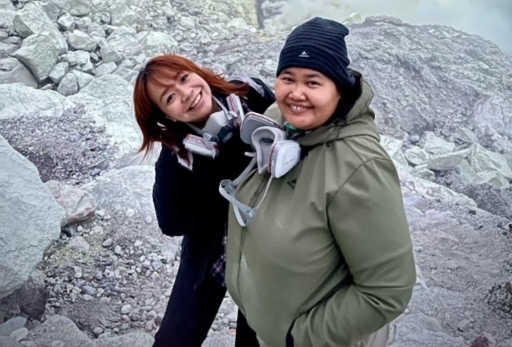I finally saw the blue fire of Mount Ijen on 13th June 2022. Actually, it was my third attempt to even reach the foot of the mountain.
My first attempt in March 2020 was a wasted seven-hour train ride from Surabaya to Banyuwangi as I discovered the local mayor closed the mountain due to COVID two hours before my arrival. I tried my luck in December 2020 but it was only open to Indonesian citizens. I nearly gave up yet decided to give it one last shot because the blue fire is so rare. There are only two places in the world to see it: ljen and Dallo Mountain, Ethiopia. Sometimes, you can also see it in the Iceland Craters.
From Bali, I went to Banyuwangi via the ferry service at Gili Ketapang. I engaged the services of Rizma Travel to arrange my trip. I met up with my travel buddy, Imelda, at the ferry terminal and we made our way to our hotel where our driver picked us up at midnight to go to Ijen.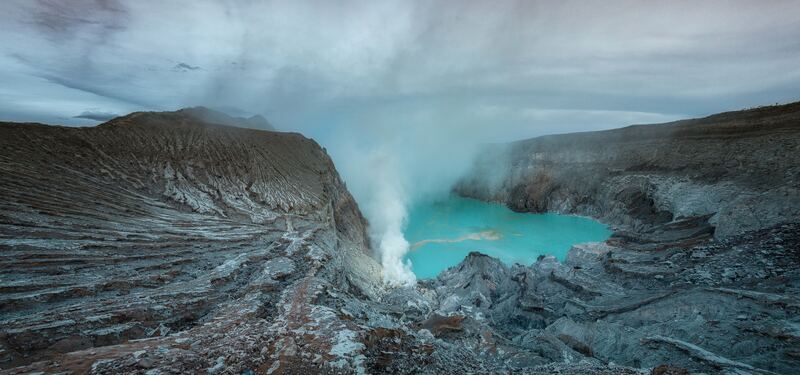
Full of anticipation, we couldn’t fall asleep. The entrance of Ijen only opened at 2am due to the ongoing pandemic, which was quite late compared to the prior opening time of 12am. I was quite worried because this left me only a short window period to hike to the summit and down to the crater to see the blue fire since it isn’t visible after sunrise.
The gate finally opened and the two-hour hike commenced. The incline was quite steep. I walked along slowly trying to catch my breath. Cold despite being geared up well with jackets and gloves, I was determined to see the blue fire. Imelda had hiked Ijen twice but wasn’t successful to see the blue fire so I really hoped this trip would work out well for both of us.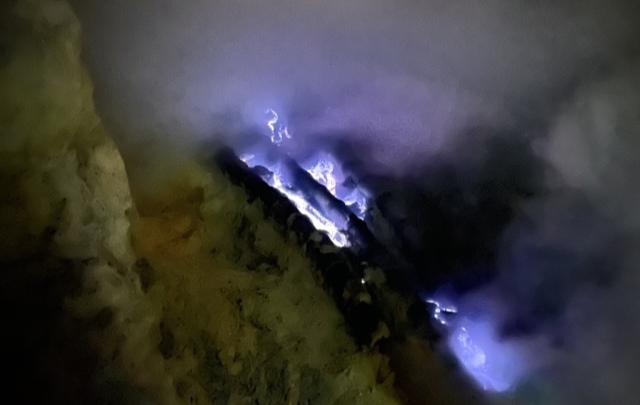
Our guide, Pak Anton, was worried that we would miss the blue fire at the rate I was walking. I needed to reach the summit and then hike down to the crater of the blue fire. Hence, he strongly recommended the trolley service to save time. The trolley service involves three men pulling a three-wheeled trolley loaded with seated passengers up the mountain. Two strong men would pull the ropes tied to the front and one man would hold the trolley handle to manoeuvre the trolley.
Deeply embarrassed, I apologised for being a heavy burden, but they claimed to be thankful because COVID had affected their earnings to feed their families. The trolley service costs Rp800,000 for a two-way trip. Use the trolley service, both to support the local economy and to save energy for the hike down from the summit to the crater and back up to the summit for a total of 2 kilometres.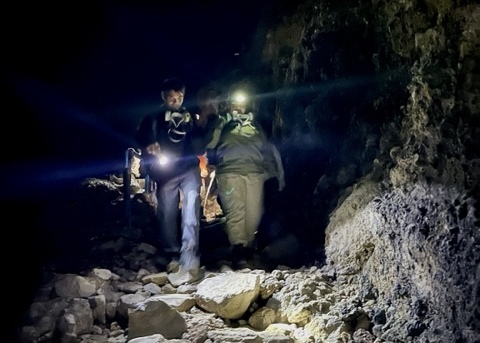
It was quite an experience sitting on the trolley; some parts of the terrain were frightening due to the steep narrow path with some sharp turns. As we got closer to the summit, the smell of sulphuric gas got stronger. After 1.5 hours, we reached the summit; dark except for torchlights used by fellow hikers. I looked down from the summit hoping to see the blue fire alas nothing but rocks were spotted. When Imelda and Pak Anton reached the summit, I voiced my confusion and was told it was impossible to sight it from here. My plan to look at the blue fire from the summit was shattered.
Hiking down to the crater shouldn’t be difficult but I was speechless when I reached the starting point – no clear path, only a crooked row of moving lights snaking down the rocky slopes, zig-zagging endlessly. It took everything in me not to give up. Pak Anton walked in front, shining his torchlight on the next rock I should step on. At times, we had to flatten ourselves to the side of the “path” so that other hikers could overtake us. Time was of the essence to see the blue fire and everyone was in a hurry.
It was tough reaching the crater. I kept thinking we reached it but there was always a turn and the light path from hikers went further, winding round and round endlessly. Bless Pak Anton’s heart, he jumped to put his hands on the boulder to protect my head as I fell down head first. I sat on a rock, shaking in shock, while other hikers squeezed their way through. I mustered up my courage and steadied my jellylike legs to continue walking.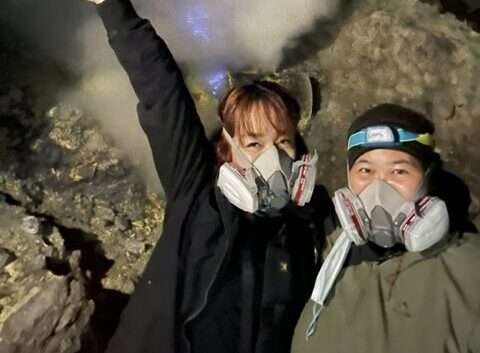
The gas fumes were getting overpowering so I put on my gas mask. A frenzy of energy and excitement signalled that I was a few metres away from the blue fire. Amidst the crowd and the gas fumes, I saw it! It was captivatingly surreal; the blue glow of light produced from the combustion of sulphuric gases; not lava as many websites state.
Astounded, the wind suddenly blew sulphuric gas right at us; engulfing, blinding our eyes and gagging our throats. The locals shouted for everyone to crouch low and hide behind any big rocks to avoid the gas while staying calm.
When the air cleared, Imelda and I wanted to quickly make our way back up to the rim of the crater to catch the sunrise. Sadly, Pak Anton told us that the sunrise from the summit would be blocked by a mountain at this time of the year, plus the sky was cloudy.
After the sunrise lit the mountain, I stood rooted to the ground, I realised I had hiked down a path that just consisted of rocks and boulders. I turned around to see the beautiful turquoise acidic crater lake of ph 0.3 acidities.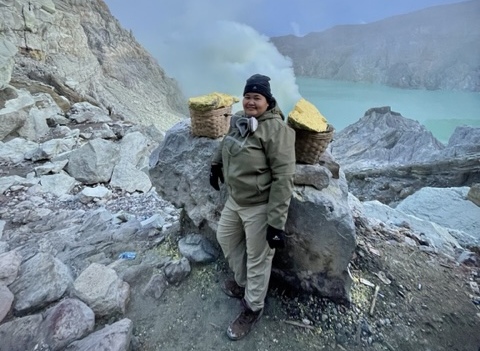
Many sulphur miners carried two heavy baskets, laden with blocks of yellow sulphur, tied to a stick carried across their shoulders. The sulphur miners made their way down to the crater to collect sulphur blocks which would be processed in factories and used in many products. They loaded their trolley with about 200 kilograms of sulphur and only get Rp1,200 (US$0.08) per kilogram of sulphur while having to traverse twice or thrice a day. Each load they carry up to the summit from the crater is approximately 75 kilograms, depending on their physical strength.
Exhausted, I hugged a boulder and refused to walk another step being on the verge of breaking down. I felt guilty and embarrassed contrasting myself to the sulphur miners in flip-flops and torn clothes.
Hiking from the summit to the crater to see the blue fire was extremely tough and scary but definitely worth every ounce of effort. Thanks to Pak Anton who was committed and believed in me and my determination to make it safely. His ability to speak fluent English and French was reassuring too.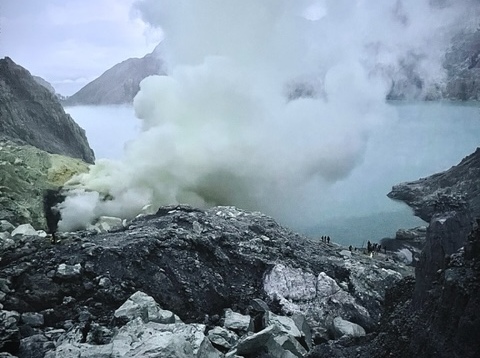
Truly an amazing experience, I wouldn’t believe it happened if not for the photos and videos Imelda took to document our journey. Would I return to Ijen again? My answer would be a resounding yes! I may return one day to Mount Ijen to take photos of the sunrise, crater lake and Milky Way.
Local guide Instagram (Pak Anton): @volcanotours_banyuwangi
Tour agency Instagram (Ibu Tiwi): @rizmatravel.sub




